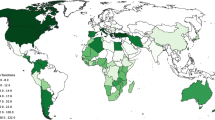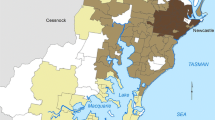Abstract
Earthquake loss estimation studies require predictions to be made of the proportion of a building class falling within discrete damage bands from a specified earthquake demand. These predictions should be made using methods that incorporate both computational efficiency and accuracy such that studies on regional or national levels can be effectively carried out, even when the triggering of multiple earthquake scenarios, as opposed to the use of probabilistic hazard maps and uniform hazard spectra, is employed to realistically assess seismic demand and its consequences on the built environment. Earthquake actions should be represented by a parameter that shows good correlation to damage and that accounts for the relationship between the frequency content of the ground motion and the fundamental period of the building; hence recent proposals to use displacement response spectra. A rational method is proposed herein that defines the capacity of a building class by relating its deformation potential to its fundamental period of vibration at different limit states and comparing this with a displacement response spectrum. The uncertainty in the geometrical, material and limit state properties of a building class is considered and the first-order reliability method, FORM, is used to produce an approximate joint probability density function (JPDF) of displacement capacity and period. The JPDF of capacity may be used in conjunction with the lognormal cumulative distribution function of demand in the classical reliability formula to calculate the probability of failing a given limit state. Vulnerability curves may be produced which, although not directly used in the methodology, serve to illustrate the conceptual soundness of the method and make comparisons with other methods.
Similar content being viewed by others
References
S. Antoniou R. Pinho (2004) ArticleTitleDevelopment and verification of a displacement-based adaptive pushover procedure Journal of Earthquake Engineering. 8 IssueID5 643–661
Applied Technology Council (1985). Earthquake damage evaluation data for California, Report ATC-13, Applied Technology Council, Redwood City, California
J.J. Bommer (2002) Deterministic vs. probabilistic seismic hazard assessment: an obstructive and exaggerated dichotomy. Journal of Earthquake Engineering. 6 IssueIDspecial issue 1 43–73
Bommer, J.J., Elnashai, A.S., Chlimintzas, G.O. and Lee, D. (1998) Review and development of response-spectra for displacement-based seismic design. ESEE Research Report No. 98-3, Imperial College, London
Bommer, J.J., Elnashai, A.S. and Weir, A.G. (2000) Compatible acceleration and displacement spectra for seismic design codes. In Proceedings of the 12th World Conference on Earthquake Engineering, Auckland, New Zealand, Paper no. 207
Bommer, J.J. and Mendis, R. (2004) Scaling of displacement spectral ordinates with damping ratios. Earthquake Engineering and Structural Dynamics, in press
J.J. Bommer R. Spence M. Erdik S. Tabuchi N. Aydinoglu E. Booth D. del Re O. Peterken (2002) ArticleTitleDevelopment of an earthquake loss model for Turkish catastrophe insurance Journal of Seismology. 6 431–446
G.M. Calvi (1999) ArticleTitleA displacement-based approach for vulnerability evaluation of classes of buildings Journal of Earthquake Engineering. 3 IssueID3 411–438
Comite Europeen de Normalisation (2003) Eurocode 8, design of structures for earthquake resistance – Part 1: General rules, seismic actions and rules for buildings, Pr-EN 1998-1. Final Draft. December 2003
Crowley, H. (2003) Periods of vibration for displacement-based assessment of RC structures. MSc dissertation, European School for Advanced Studies in Reduction of Seismic Risk (ROSE School), University of Pavia, Italy
H. Crowley R. Pinho (2004) ArticleTitlePeriod-height relationship for existing European reinforced concrete buildings Journal of Earthquake Engineering. 8 IssueIDspecial issue 1 93–119
C. Dymiotis A.J. Kappos M.K. Chryssanthopoulos (1999) ArticleTitleSeismic reliability of RC frames with uncertain drift and member capacity Journal of Structural Engineering. 125 IssueID9 1038–1047
FEMA (1999) HAZUS99 – Earthquake Loss Estimation Methodology: User’s Manual Federal Emergency Management Agency Washington, DC
FEMA (2001) HAZUS99: Estimated Annualized Earthquake Losses for the United States. FEMA 366 Federal Emergency Management Agency Washington, DC
P. Franchin A. Lupoi P.E. Pinto (2002) ArticleTitleMethods for seismic risk analysis: state of the art versus advanced state of the practice Journal of Earthquake Engineering. 6 IssueIDspecial issue 1 131–155
S.A. Freeman D.L. Messinger W.L. Casper L.W. Mattis F.R. Preece R.E. Tobin (1985) ArticleTitleStructural moments no. 4. drift limits: are they realistic? Earthquake Spectra. 1 IssueID2 203–390
S. Glaister R. Pinho (2003) ArticleTitleDevelopment of a simplified deformation-based method for seismic vulnerability assessment. Journal of Earthquake Engineering. 7 IssueIDspecial issue 1 107–140
R. Iaccino (2004) Probabilistic implementation of a mechanics-based procedure for seismic risk assessment of classes of RC buildings. MSc Dissertation, European School for Advanced Studies in Reduction of Seismic Risk (ROSE School) University of Pavia Italy
Joint Committee for Structural Safety (JCSS) (2001) Probabilistic Model Code – Working document. Last update 13/03/2001 (online). Available from URL: www.jcss.ethz.ch
A.J. Kappos M.K. Chryssanthopoulos C. Dymiotis (1999) ArticleTitleUncertainty analysis of strength and ductility of confined reinforced concrete members Engineering Structures. 21 195–208
C.A. Kircher A.A. Nassar O. Kustu Holmes W.T. (1997) ArticleTitleDevelopment of building damage functions for earthquake loss estimation Earthquake Spectra. 13 IssueID4 663–682
P. Miranda (2004) Displacement capacity of RC columns with limited shear resistance. MSc Dissertation, European School for Advanced Studies in Reduction of Seismic Risk (ROSE School) University of Pavia Italy
S.A. Mirza J.G. MacGregor (1979) ArticleTitleVariations in dimensions of reinforced concrete members Journal of the Structural Division, Proceedings of the American Society of Civil Engineers. 105 IssueIDST4 751–766
S.A. Mirza J.G. MacGregor (1979) ArticleTitleVariability of mechanical properties of reinforcing bars Journal of the Structural Division. Proceedings of the American Society of Civil Engineers. 105 IssueIDST5 921–937
R.M.W. Musson (2000) ArticleTitleIntensity-based seismic risk assessment Soil Dynamics and Earthquake Engineering. 20 353–360
Ordaz, M., Miranda, E. Reinoso, E. and Pérez-Rocha, L.E. (2000) Seismic loss estimation model for Mexico City. In Proceedings of the 12th World Conference on Earthquake Engineering, Auckland, New Zealand, Paper no. 1902
Pinho, R., Bommer, J.J. and Glaister, S. (2002) A simplified approach to displacement-based earthquake loss estimation analysis. In Proceedings of the 12th European Conference on Earthquake Engineering, London, England, Paper no. 738
P.E. Pinto R. Giannini P. Franchin (2004) Methods for Seismic Reliability Analysis of Structures IUSS Press Pavia, Italy
M.J.N. Priestley (1997) ArticleTitleDisplacement-based seismic assessment of reinforced concrete buildings Journal of Earthquake Engineering. 1 IssueID1 157–192
M.J.N. Priestley (2003) Myths and fallacies in earthquake engineering – revisited. The Mallet-Milne Lecture IUSS Press Pavia, Italy
L.F. Restrepo-Velez (2004) A simplified mechanical-based procedure for the seismic risk assessment of unreinforced Masonry buildings. Individual Study ROSE School Pavia, Italy
L.F. Restrepo-Velez J.J. Bommer (2003) ArticleTitleAn exploration of the nature of the scatter in ground-motion prediction equations and the implications for seismic hazard assessment Journal of Earthquake Engineering. 7 IssueIDspecial issue 1 171–199
Restrepo-Velez, L.F. and Magenes, G. (2004) Simplified procedure for the seismic risk assessment of unreinforced masonry buildings. In Proceedings of the 13th World Conference on Earthquake Engineering, Vancouver, Canada, Paper No. 2561
T. Rossetto A. Elnashai (2003) ArticleTitleDerivation of vulnerability functions for European-type RC structures based on observational data Engineering Structures. 25 1241–1263
M. Sasani A. Kiureghian ParticleDer (2001) ArticleTitleSeismic fragility of RC structural walls: displacement approach ASCE Journal of Structural Engineering. 127 IssueID2 219–228
R. Spence J.J. Bommer RD. Del J. Bird N. Aydinoglu S. Tabuchi (2003) ArticleTitleComparing loss estimation with observed damage: a study of the 1999 Kocaeli earthquake in Turkey Bulletin of Earthquake Engineering. 1 IssueID2 83–113
Author information
Authors and Affiliations
Corresponding author
Rights and permissions
About this article
Cite this article
Crowley, H., Pinho, R. & Bommer, J.J. A Probabilistic Displacement-based Vulnerability Assessment Procedure for Earthquake Loss Estimation. Bull Earthquake Eng 2, 173–219 (2004). https://doi.org/10.1007/s10518-004-2290-8
Received:
Accepted:
Issue Date:
DOI: https://doi.org/10.1007/s10518-004-2290-8




